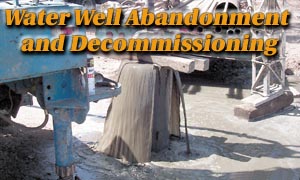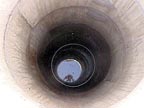
Wells are expensive commodities and generally are an asset to the property even if they are not currently in use - as long as they are properly maintained. Proper maintenance may be as simple as making sure that the well head remains above the land surface where it is protected from flooding. The well also must be fitted with a sanitary well cap or concrete cover depending on the type of well so that contaminants cannot enter the well.
If it is decided that a well has no useful purpose, has no potential future use or has no real value and actually could constitute a liability, then the well is, for all practical purposes, abandoned and must be properly decommissioned.
Wells that are unused and have been improperly decommissioned (abandoned) pose a serious risk to ground water quality. Improperly decommissioned wells can directly channel contaminated surface water into ground water. Since ground water flows through soil and rock formations, contamination from an improperly decommissioned well can spread to other wells in the area. Because of these risks, abandoned wells must be filled, sealed and plugged.

Risks Posed
There are very good reasons to make sure abandoned wells are properly decommissioned.
- Improperly abandoned wells threaten drinking water supplies by providing open conduits into aquifers that have potential to supply drinking water to public or private wells.
- Any contaminants entering an abandoned well from the surface can travel easily into different water-bearing formations whether in coarse sand and gravel aquifers or in bedrock fracture zones and can cross-contaminate a number of water-bearing formations within one well.
- If a drinking water well is being replaced because of water quality problems in the original well, the abandoned well is a direct threat to the new water supply if it is not properly sealed.
- Improperly abandoned wells can create a liability problem at the time of property resale or if the well causes contamination in neighboring wells.
- Shallow dug wells create a physical hazard simply because of their large diameter and the potential for animals or people to fall into them. Typically, the older fieldstone-lined wells are the most dangerous because many were finished flush to the ground surface and were covered with wooden covers which now are decayed or non-existent.
Most of the well contaminants that commonly cause concern originate aboveground, often as the result of human activities. Disease-causing bacteria and viruses, pesticides, fuels and industrial chemicals are examples of pollutants that can contaminate a ground water supply. Spills and careless storage or use of chemicals, and poor treatment and disposal of waste materials often are to blame.
Soil overlying the water table provides the primary protection against ground water pollution. Bacteria, sediment and other insoluble forms of contamination become trapped within the soil pores. Some chemicals are adsorbed or react chemically with various soil constituents, thereby preventing or slowing the migration of these pollutants into the ground water. In addition, plants and soil microorganisms use some potential pollutants, such as nitrogen, as nutrients for growth, thereby depleting the amount that reaches the ground water.
Well owners sometimes are tempted to use illegal wells to dispose of sewage and other wastes. This is unacceptable; it is literally like pouring waste directly into your drinking water, and the health risks can't be overstated.
Background Info
It is necessary to know some background information on the well - when it was constructed and by whom, as well as the methods used in construction. This information normally is available from the appropriate agency responsible for water resources.An unconfined formation is made up entirely of porous material. Water can move freely throughout the entire formation (aquifer).
In a confined formation, layers of impermeable material separate water-bearing zones from each other. Under normal circumstances, water can't move freely from one zone to another. Water from different water-bearing zones in the same confined formation shouldn't be allowed to mingle. When decommissioning a well, grout seals must be used to prevent water movement into or between different zones. There are several different types of grout that can be used: neat cement grout, sand cement grout, concrete grout or bentonite grout. Neat cement grout and bentonite grout can be used in any geologic formation; sand cement gout and concrete grout shouldn't be used below the water table.
Within the same water-bearing zone in a confined formation or in an unconfined aquifer, sealing isn't necessary and a fill material can be used instead. Fill material can be sand, gravel, limestone, crushed stone or grout. It should be free of any chemical residue and other foreign materials. In large-diameter dug wells, native topsoil is permitted as a fill material because of the large volume required.

Removal of Well Equipment
Having determined the means by which the well will be filled and sealed, the next step is to remove the well equipment (well pump, piping, etc.) and any other obstructions. If an obstruction can't be removed, the well should be grouted from the bottom to a point above the obstruction. If this isn't possible, a minimum five-foot grout seal should be placed above the obstruction. Before any fill or grout is added, the well should be disinfected with a chlorine solution. Sand and gravel fill also should be disinfected with a chlorine solution.There is a variety of acceptable grout and fill materials used for sealing wells:
- Portland cement, otherwise known as neat cement, mixed with five gallons to six gallons of clean water per 94-pound bag.
- Cement-bentonite grout, which is a mixture of Portland cement with 2 percent to 10 percent bentonite clay, mixed according to the proper water-to-cement ratio, depending on the percent by weight of bentonite added. This sealant is the recommended material to use when decommissioning a contaminated well because, unlike neat cement that shrinks and can crack upon curing, cement-bentonite grout swells and remains plastic when cured, which in turn creates a superior seal.
- Bentonite chips can be used for filling and sealing wells or portions of wells by applying directly into the well through the top at a rate no greater than three minutes per bag. When hydrated, bentonite chips will swell up to 12 to 13 times their dry volume and effectively seal the well. If the chips are applied at a rate greater than three minutes per bag, bridging can occur within the well and the well will not be filled. For this reason, it is not recommended that bentonite chips be used for the entire depth of the well or much greater than 50 feet below the static water level.
Once the well has been cleared of equipment and disinfected, it can be filled in. The well has to be filled or grouted from the bottom of the well to three feet below the ground surface. A minimum three-foot grout seal needs to be placed above the static water level (top of the water table), regardless of whether the well is in a confined or unconfined formation. Grout seals between water-bearing zones in a confined formation should be at least six feet long. The grout should be placed in the well using a conductor pipe; the bottom of the pipe should remain submerged during grouting. Chlorinated fill material can be used between grout seals.
- Abandoned drilled wells penetrating fractured bedrock should be sealed by filling or grouting the well from a minimum of 40 feet below the bottom of the casing to the top of the well. Coarse fill material may be used in the remainder of the well to support the seal material.
- Abandoned drilled wells penetrating unconsolidated materials should be sealed by filling or grouting the well from the bottom of the well to the top.
- Drilled wells that have been contaminated due to a construction deficiency or continue to cause an environmental hazard should be sealed by pressure grouting the well. This is done with a conductor (tremie) pipe, starting at the bottom of the well and slowly raising the conductor pipe toward the top of the well at a rate no faster than the grout material fills and displaces water from the well and until the well is completely filled. The grout mixture used should be a Portland cement mixed with 2 percent to 10 percent high-solids bentonite clay mixed according to the correct water-to-cement ratio.
- Abandoned shallow dug wells should be filled and sealed by placing clean fill material free of organic matter into the well. Often, locally available fill materials are adequate to complete the job. The upper two feet should be filled with impervious material, such as clay or hardpan, and slightly mounded to prevent the entry of surface water runoff.

Capping
After the well has been filled and sealed, it must be capped. The well records should indicate if the well was equipped with a surface seal. If the well does have a surface seal, the remainder of the well casing should be filled with grout and a watertight cover should be installed on top. If there was no surface seal installed, the top three feet of well casing should be removed and a 10-foot grout seal should be placed. The remainder of the hole can be filled in with concrete, cement grout or native topsoil. If topsoil is used, it should be mounded to allow for settling, so that surface water will always drain away from the well.ND

Report Abusive Comment